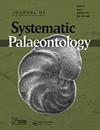古吉拉特邦印度,南亚最古老的偶蹄动物(哺乳类):新的牙齿材料和系统发育关系
IF 2.2
2区 地球科学
Q3 EVOLUTIONARY BIOLOGY
引用次数: 0
摘要
摘要双足类被广泛认为是由最古老、最原始的偶蹄类动物组成的副进化类群,它们在古新世-始新世边界附近突然出现在北方各大洲。在南亚,偶蹄动物的第一个记录是来自印度Vastan褐煤矿的早期伊普勒斯(~ 55 Ma) Cambay页岩的Gujaratia indica的出现,它比来自欧洲和北美的最古老的偶蹄动物略年轻。在此,我们描述了新的牙材料,记录了相关的上牙列,包括P4,一个新的位点。古吉拉特邦(包括G. pakistan和G. indica)明显不同于所有已知的双齿纲动物,因为它有最多的三角形上磨牙和较弱的副磨牙。古吉拉特邦与其他双足类、双足类、双足类和双足类的系统发育关系分析表明,古吉拉特邦是单系的,而双足类和双足类是强多系的。古吉拉特邦被发现与北美的diacodexeids和来自欧洲的D. gigasei和D. morrisi更接近,它们形成了一个副类群。欧洲双齿兽代表了一个非自然的类群,其中D. antunesi与一个由二齿兽和同齿兽组成的分支关系最密切,D. gazini和D. varleti在一个由铁齿兽和巴齿兽组成的分支中占据基础位置。双齿虫科也被恢复为一个多系群,而锥齿虫科是副系群。长期以来被认为是印度次大陆特有的Raoellids和pakicetids是单系的,与古吉拉特邦没有密切的亲缘关系,似乎与一些欧洲的双翅目动物(如d.g azini)有更密切的联系,需要重新评估目前关于偶蹄动物起源的观点。我们感谢两位匿名审稿人和编辑的建设性意见,他们的意见有助于改进本文。我们感谢D. Datta对系统发育的有益评论。我们感谢D. Das、V. V. Kapur、N. Saravanan和R. Sharma在实地工作期间提供的协助,并感谢GIPCL的官员和工作人员允许我们在Vastan褐煤矿工作并提供后勤支持。我们还要感谢A. Juyal在印度理工学院鲁尔基分校地球科学系拍摄的扫描电镜图像。AR感谢印度政府新德里CSIR Shyama Prasad Mukherjee奖学金(SPM09/0143(16119)/2022-EMR-I)提供的资金支持。SB感谢DST、印度政府(SR/S4/ES-222/2006)和IITR研究所主席教授的支持。作者报告无利益竞争需要申报。补充材料本文的补充材料可以在这里访问:http://dx.doi.org/10.1080/14772019.2023.2267553.Associate编辑:Alistair evans补充信息资助我们感谢两位匿名审稿人和编辑的建设性意见,这些意见有助于改进本文。我们感谢D. Datta对系统发育的有益评论。我们感谢D. Das、V. V. Kapur、N. Saravanan和R. Sharma在实地工作期间提供的协助,并感谢GIPCL的官员和工作人员允许我们在Vastan褐煤矿工作并提供后勤支持。我们还要感谢A. Juyal在印度理工学院鲁尔基分校地球科学系拍摄的扫描电镜图像。AR感谢印度政府新德里CSIR Shyama Prasad Mukherjee奖学金(SPM09/0143(16119)/2022-EMR-I)提供的资金支持。SB感谢DST、印度政府(SR/S4/ES-222/2006)和IITR研究所主席教授的支持。本文章由计算机程序翻译,如有差异,请以英文原文为准。
Gujaratia indica , the oldest artiodactyl (Mammalia) from South Asia: new dental material and phylogenetic relationships
AbstractDiacodexeids are widely considered to be a paraphyletic group consisting of the oldest and most primitive artiodactyls that made their sudden appearance in all northern continents around the Palaeocene–Eocene boundary. In South Asia, the first record of artiodactyls is marked by the appearance of Gujaratia indica from the early Ypresian (∼55 Ma) Cambay Shale of the Vastan lignite mine, India, which is slightly younger than the oldest artiodactyls from Europe and North America. Here we describe new dental material of G. indica, documenting associated upper dentition, including P4, a new locus. Gujaratia (including G. pakistanensis and G. indica) is clearly distinct from all known diacodexeids in having the most triangular upper molars and lower molars with weaker paraconids. Cladistic analysis performed to assess the phylogenetic relationships of Gujaratia with other diacodexeids, dichobunoids, raoellids and pakicetids shows that Gujaratia is monophyletic while Diacodexis and Diacodexeidae are strongly polyphyletic. Gujaratia is found to be closer to the North American diacodexeids and D. gigasei and D. morrisi from Europe, which form a paraphyletic group. The European Diacodexis represents an unnatural grouping with D. antunesi being most closely related to a clade comprising dichobunids and homacodontids, and D. gazini and D. varleti occupying basal positions in a clade comprising raoellids and pakicetids. Dichobunidae is also recovered as a polyphyletic group whereas Homacodontidae is paraphyletic. Raoellids and pakicetids, long considered to be endemic to the Indian subcontinent, are monophyletic and without close affinities to Gujaratia, and appear to be more closely allied to some European dichobunoids, e.g., D. gazini, necessitating a reappraisal of current ideas about artiodactyl origins.Keywords: EoceneGujaratiaphylogenyDiacodexeidaeIndian subcontinent AcknowledgementsWe thank the two anonymous reviewers and the editors for their constructive comments which helped improve the manuscript. We thank D. Datta for helpful comments on phylogeny. We are grateful to D. Das, V. V. Kapur, N. Saravanan and R. Sharma for assistance during the fieldwork, and the officials and staff of GIPCL for permission to work and for logistic support in the Vastan lignite mine. We also thank A. Juyal for taking SEM images at the Dept. of Earth Sciences, IIT Roorkee. AR acknowledges financial support provided under the Shyama Prasad Mukherjee Fellowship, CSIR, New Delhi, Government of India (SPM09/0143(16119)/2022-EMR-I). SB acknowledges support obtained from DST, Government of India (SR/S4/ES-222/2006) and the IITR Institute Chair Professorship.Disclosure statementThe authors report there are no competing interests to declare.Supplemental materialSupplemental material for this article can be accessed here: http://dx.doi.org/10.1080/14772019.2023.2267553.Associate Editor: Alistair EvansAdditional informationFundingWe thank the two anonymous reviewers and the editors for their constructive comments which helped improve the manuscript. We thank D. Datta for helpful comments on phylogeny. We are grateful to D. Das, V. V. Kapur, N. Saravanan and R. Sharma for assistance during the fieldwork, and the officials and staff of GIPCL for permission to work and for logistic support in the Vastan lignite mine. We also thank A. Juyal for taking SEM images at the Dept. of Earth Sciences, IIT Roorkee. AR acknowledges financial support provided under the Shyama Prasad Mukherjee Fellowship, CSIR, New Delhi, Government of India (SPM09/0143(16119)/2022-EMR-I). SB acknowledges support obtained from DST, Government of India (SR/S4/ES-222/2006) and the IITR Institute Chair Professorship.
求助全文
通过发布文献求助,成功后即可免费获取论文全文。
去求助
来源期刊
CiteScore
5.30
自引率
7.70%
发文量
31
审稿时长
>12 weeks
期刊介绍:
The Journal of Systematic Palaeontology publishes papers that provide novel and impactful results in phylogenetics and systematics and that use these results in ways that significantly advance rigorous analyses of palaeogeography, palaeobiology, functional morphology, palaeoecology or biostratigraphy. Papers dealing with theoretical issues or molecular phylogenetics are also considered if they are of relevance to palaeo-systematists. Contributions that include substantial anatomical descriptions, descriptions of new taxa or taxonomic revisions are welcome, but must also include a substantial systematics component, such as a new phylogeny or a revised higher-level classification. Papers dealing primarily with alpha-taxonomic descriptions, the presentation of new faunal/floristic records or minor revisions to species- or genus-level classifications do not fall within the remit of the journal.

 求助内容:
求助内容: 应助结果提醒方式:
应助结果提醒方式:


